Poster presented to the ICHM Meeting in Polling, Germany (July 2004)
The observation of the atmosphere in Tenerife island during the last
centuries and the mountain observatory in Izaña
Fernando De Ory1, Manuel Palomares21Instituto N. de Meteorología, C. de la Marina 20, Sta. Cruz de Tenerife 38071 Spain
2Instituto Nacional de Meteorología, Apartado 285, Madrid 28071, Spain
1fernandodeory@yahoo.es – 2palomares@inm.es
1 Introduction
Tenerife, the biggest of the Canary Islands, has attracted scientific interest since early times particularly after Humboldt’s reports of his visit in 17991. Its geographical emplacement and its high mountains are ideal for astronomical and meteorological observations and the history of these sciences has several interesting links with the observations and studies made at the island. In the early years of the 20th century the European meteorological community expressed deep interest in establishing a permanent observatory in the mountains of the island. The second part of this paper addresses the history of the foundation of the observatory in Izaña in which scientific negotiations merged with strategic developments in the European politics of that time.
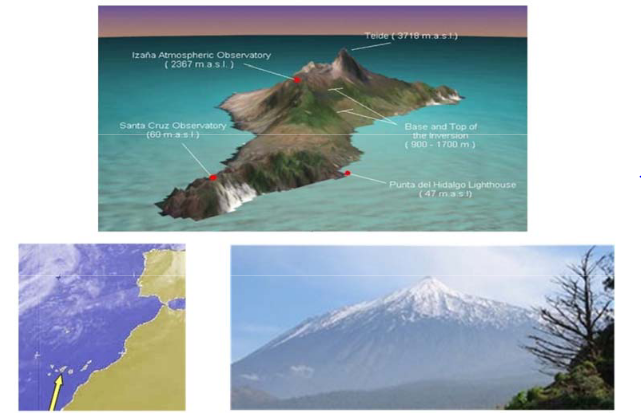
Figure 1. Tenerife, the largest of the seven isles in the Canary Archipelago is an island of volcanic origin, which can be traced to times towards the end of the Tertiary period some seven million years ago. Located a little to the north of the Tropic of Cancer, Tenerife is just over 300 km away from the African continent and about 1200 km from the Iberian Peninsula. With a surface of 2034 km² and distinct triangular shape it is a mountainous island. The gigantic massif of Teide, sits above the circular formation of Las Cañadas. The Teide, 3718 m high, is the third largest volcano on Earth.
1 Humboldt A. von, (1805)
2 Early meteorological observations.
The Canary Islands were colonized by Spain in the 15th century and soon became a strategic stopping place in the route to America. Trade flourished and people of many different places in Europe visited the islands or established in the main harbour cities. Tenerife and the peak of Teide had been present in the books and reports by European travellers, geographers and naturalists for centuries. Before 1600 many believed that the Teide was the highest mountain in the world.
The earliest antecedent of scientific works on Teide’s Peak that we know of, dates back to 1645. Only two years after Torricelli had taken the first barometer measurements the Royal Society of London requested the permission of the Spanish Ambassador to Great Britain for two fellows of the Society to visit Tenerife in order to measure the “weight of the air” at the Peak. In 1724 the Paris Academy of Science also sent one of its members, P. Feuillé, to the island to carry out several studies. In the 18th century many other travellers, sailors and scientists carried out works on the geographical characters with references to meteorological observations.
In June 1799 Alexander von Humboldt climbed up the Teide taking measurements of the air temperature and pressure, and collected geological, flora and vegetation data. He was the first one in fixing the altitude of the sea cloud at around 1200 m., and explained the essential causes2. Charles Darwin arrived to Tenerife with the “Beagle” expedition on 6th January 1832, although he was unable to disembark due to rumours of a cholera epidemic in his ship. In his diary Darwin mentioned the diameter of dust particles and the importance of the Sahara’s wind for this phenomenon.
The first book specializing in the climate of the Canary Islands dates from 1823 and was written by the German geologist Leopold von Buch3. En 1847 the French scientists Arago and Desperray made plans for the establishment of an observatory in Tenerife with the support of the naturalist Sabin Berthelot, consol of France in the island at the time. The interest of the project, under Berthelot’s writings4, was the situation close to the Tropics, the altitude of the mountains and the clean air permitting excellent observations. In 1850 the astronomer Charles Piazzi Smith spent two months in a place named Altavista, near Teide’s Peak, carrying out astronomical observations5. He also provided fundamental data concerning Teide’s wind and climate. Ozone measurements were performed in Tenerife as early as 1862-1863 with the purpose of investigating an outbreak of yellow fever.
In 1888 Ralph Abercromby published a report on “the electrical and meteorological observation on Tenerife’s Peak”6. He had been in the island in 1887 and climbed the Teide. Some years later he published jointly with Teisserenc de Bort and Hildebrandson, the International Cloud Atlas of which several pictures were taken in Tenerife. Other papers and reports were published by astronomers and meteorologists during the last years of 19th century, some of them as renowned as K. Angstrom who published in Upsala the results of work done in Tenerife on “The intensity of solar radiation at several altitudes”.
An important milestone in the history of the scientific interest for Tenerife was its relation with the progress made on the understanding of the atmosphere general circulation, through the observation of Trade and Counter-Trade winds in the island. Leonardo Torriani an Italian engineer at the service of King Phillip II identified already in 1592 the phenomena associated with the trade-winds inversion in the slopes of the Teide: “The air is so much dry that I consider, from my own experience, that no human would be able to remain there for more than 24 hours. The winds above blow strong … from all that I guess that it is must be the highest part of the first region of air” 7.
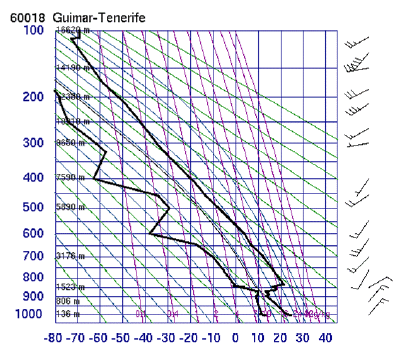
Figure 2. Typical atmospheric sounding in Tenerife. Trade wind inversion is found in the layer between 1300 and 1600 metres. The maximum humidity at 1300 m marks the altitude of the “sea of clouds” which can be often contemplated from above when climbing up the mountains in the island. Up from the inversion the wind direction turns from NE to SW with much drier air than at low levels.
The North-easterly Trade Winds regime, well known to Portuguese and Spanish sailors since the 15th century, was described in detail by Edmund Halley when he published his “First Wind charts” in the “Transactions Philosophiques” (1686). The drastic change of direction from these usual winds in the coast of Tenerife to an almost permanent Southwest wind observed in its high mountains called very soon the attention of scientists.
An early explanation was provided by George Hadley when he described the Equatorial circulation cell in 1735. When William Ferrel published in 1856 his work on the model of the atmospheric circulation (revised in 1860 and 1889) he made explicit mention of the winds observed in Tenerife. The explanation by Ferrel continued to be investigated during the next years. Carl von Fristch, Vice-director of the Central Institute for Meteorology and Geodynamics (ZAMG) in Vienna spent a long period in Tenerife during 1864, observing and studying the trade winds and counter-trade winds regime8. Later Julius Hann, director of ZAMG, published several studies based on the observations in Tenerife9.
2 Humboldt A. Von (1805)
3 Buch L. von (1823)
4 Berthelot, S.
5 Piazzi Smith C. (1856)
6 Abercromby, R. in Journal of the RMS (1888)
7 Torriani, L. (1590)
8 Fritsch, K. von (1866)
9 Hann, J. von (1897 and 1906)
3 The foundation of the Tenerife observatory
The new methods for observation of upper air by means of free balloons and kits had been developed by the end of 19th century and soon the observation campaigns in Tenerife came into fashion among the meteorological community. The first ones were led by Professor Hugo Hergesell director of the Strasbourg observatory and president of the International Commission for Scientific Aerostation (ICSA)10. In August 1904 and again in April and September 1905, he was in Tenerife on board of the yacht “Princesse Alice” with the yacht’s patron and Hergesell’s close friend Prince Albert of Monaco, an enthusiastic supporter of scientific research11.
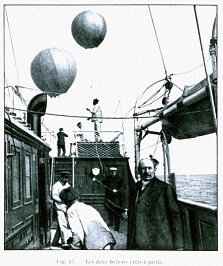
Figure 3. Hugo Hergesell on board of the “Princesse Alice” in Tenerife waters. In the background pilot balloons for wind observation about to be released.
Two famous pioneers of upper air observations, the French Léon Teisserenc de Bort and the American Lawrence Rotch visited Tenerife in 1905 with the ship “Otaria” launching 40 pilot and captive balloons from the peak on 8-10 August. They also made a number of observations and atmospheric soundings in the surrounding sea in the summer of 1905 and again in February 1906>12. One basic objective was to distinguish the orographic influence of the Teide mountain from the wider circulation regime. The first simultaneous soundings in Tenerife were made on 28 July 1908, by Robert Wenger at the Orotava valley and Hergesell on board of the German warship “Victoria Luisa”.
The international interest in establishing a permanent Observatory at Teide’s Peak increased in those years, and Teisserenc de Bort presented a proposal at the ICSA meeting of Milan in 190613. The observatory would be part of an ambitious project for an aerological network in the Northern Hemisphere. Spain was represented in the ICSA and the proposal was formally submitted to her authorities with little response by them. However at the same time interest was significantly growing on the part of Germany and her government made diplomatic approaches to Spain on the issue of the observatory. It is highly probable that scientific objectives were merging with other ones. The expedition of 1908 had been funded by the German government using ships of the Imperial Navy. Hergesell, who was in charge, enjoyed the protection of Kaiser Willem as one of his main scientific advisors and had established close relation with Count von Zeppelin and the German aeronautical enterprises. The important observatory in Lindenberg had been inaugurated in 1905, under the direction of R. Assman, one of its objectives being the meteorological support to zeppelins flights. An observatory in Tenerife, half way between Germany and her African territories, could have important strategic interest for related purposes and other objectives as a centre for telecommunications and logistics.
Things began to happen very quickly during the first months of 1909. In February a piece of land in Las Cañadas, 2200 m high in the slopes of the Teide, was hired by German agents in Tenerife. It was only by chance that just at the same time Colonel Vives, the Spanish representative to ICSA, travelled to Germany with scientific purposes. Once there Hergesell informed him of the actions for establishing immediately an observatory with “means provided by him to ICSA” and asked Vives to request the support of the Spanish authorities. However no previous notice had been given about the initiative and it was soon revealed that important resources had already been mobilised by the German government. In fact only a few days later all the material for the observations was shipped in Hamburg. Not much later the German Navy carried to Tenerife two large portable huts, lent by Kaiser Willem II14, to be installed at Las Cañadas.
The early 20th century was a time of political tension in Europe and significant rivalry between France and Germany in North-Africa. Spain was administrating territories in the Canaries and in the African continent and was much concerned about the developments15.
The Spanish government got aware of the German movements through the information provided by Vives and the Spanish embassy in Berlin. Its concern was quickly transmitted through diplomatic channels and negotiations with the German government were conducted during the following weeks. In the mean time Hergesell had travelled to Tenerife in early March and signed himself the official request to the local authorities for establishing the observatory16.
The outcome of the diplomatic negotiations made the Spanish government to take the only decision that probably could avoid a conflict with Germany on the issue of the observatory. Although the question had been discussed at high political levels by both governments the result was communicated within the terms of international scientific co-operation. Vives telegraphed to Hergesell on 20 March that the Spanish government had decided to install at its own expenses the observatory in Tenerife and would co-operate with the ICSA in the preliminary works. Hergesell was then preparing his return from Tenerife as he had to chair the next meeting of the ICSA in Monaco, scheduled to open on 31 March. Instead of travelling directly to Monaco Hergesell went to Madrid where he held conversations with Vives and the Minister of Foreign Affairs on 28 March.
The final outcome of the negotiations was communicated at the 6th ICSA conference in Monaco17. Hergesell announced that it was proposed to grant Spain the provisional use of the two huts “provided to the ICSA by the emperor of Germany”. Then Colonel Vives took the floor as Spanish representative and announced that Spain has committed to build a permanent meteorological observatory in the mountains of Tenerife. It would be complemented with another observatory at sea level. He would be glad to accept, on behalf of his government, the ICSA installations in Las Cañadas to be rendered back for use in other parts of the world when the new observatory was designed and built. In the mean time Spain would take charge of the installation of the provisional observatory but “the visits of scientists wishing to make their studies will be very welcome”.
The Monaco conference also deserves a special mention for the historical and relevant participation of Vilhelm Bjerknes18, who was appointed as member of ICSA at that meeting. Dr. Robert Wenger, assistant of Hergesell in Tenerife, reported about the observation campaign at the island in July-August 1908. His report included interesting notices on the influence of an Atlantic depression over the normal trade winds regime, the strengthening of winds at high levels and changes on the thickness of trade winds and counter-trade winds19.
Following the compromise announced at the conference in Monaco the installation of the provisional observatory in Las Cañadas was completed by Spanish staff by the autumn of 1909 and the first observations were done by A. Gordejuela. Robert Wenger arrived in November 1909 with his assistant A. Stark and was the main responsible for the work done during the next years. He published the first studies with Hergesell in 191120.
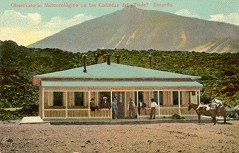
Figure 4. “Kaiser’s hut” installed in Las Cañadas with the Teide in the background
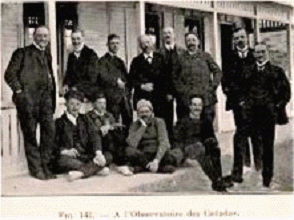
Figure 5. Scientists asembled at Las Cañadas observatory for the international scientific campaign of 1910. Dr. Wenger is second to the right in the back row. Second on the right in the first row is the famous astronomer M.J. Mascart.
During those years there were Spanish staff collaborating with the German team and a considerable number of visits by foreign scientists, most of them also Germans such as Professor Lüdeling and Dr. Luyken of the Köeniglich Meteorological Institute, Dr. Dember, professor at Dresde’s Physics Institute, Martin Uibe, W. Buchheim (Leonardville University, USA.) and others. They made observations on atmospheric electricity, magnetic declination, ultraviolet solar radiation, skylight polarization, ionization, optics etc. According to the quality of the results, it was emphasized that due to low dust and mist content “Teide’s Peak was more suitable for physics and astrophysics research than the mountains of Switzerland or Italy”21.
By 1913 the German resident scientists had left Las Cañadas and the observatory was managed by the Spanish engineer García-Lomas although foreign scientists continued to visit the place. The activity was quite reduced after the break of the war and following the inauguration of the new observatory in Izaña the activity in Las Cañadas was abandoned.
During the two years following the Monaco Conference the pressure on the Spanish authorities to build the permanent observatory increased progressively. In fact the Spanish government had committed to a project which it would have not undertaken for mere scientific purposes at that time. In 1909 meteorological research was almost inexistent in Spain and upper air observation was only done by the army in support of balloons flights (The ICSA representative, colonel Vives, was the head of the aerostation branch of the army). The Weather Service was a small organism owning only the central observatory in Madrid, other observatories belonging to universities and other institutions. On the other hand building an observatory in the mountains of Tenerife was quite an expensive task. Thus the implementation of the acquired commitment was delayed for nearly three years.
In October 1911 a scientific expedition was charged to find the most appropriate place and the choice was the mountain of Izaña at the top of a mountain plateau, 2367 m above sea level, on the ridge crossing the island. The project was presented at the ICSA meeting of 191222 by the new director of the Weather Service, José Galbis, who had involved himself actively in the project23. Following further delays, while waiting for administrative decisions and the approval of funds, the building works finally began in 1914. The observatory was inaugurated on the first day of 1916 and since then it has been managed by the Spanish weather service (currently the National Institute of Meteorology, INM)24.
10 Minutes of the ICSA (“Commision Internationale pour l’Aerostation Scientifique”) meeting in Saint Petersburg, 1904, Annex VII. The ICSA was established in 1896 by the International Meteorological Committee which was the executive body of the International Meteorological Organization (IMO). It held general meetings in 1898, 1900, 1902, 1904, 1906, 1909 and 1912. After the 1st World War it was renamed as the International Commission for the Exploration of the Upper Atmosphere. Years later it would become the current Commission of Atmospheric Sciences of the World Meteorological Organization.
11 Accounts of these expeditions written by Hergesell are found in the bulletins of the Oceanographic Museum in Monaco, nrs. 50 & 53.
12 Minutes of the 5th ICSA meeting, Annex XV
13 Minutes of the 5th ICSA meeting, Annex XV, pp 105-106
14 In fact the portable huts were used by the Kaiser for short stops in his train travels throughout Germany.
15 F. De Ory (1998). This book includes many references about the issue of the meteorological observatory in Tenerife found in the archives of the Spanish Foreign Ministry in Madrid, particularly in the reports of the Spanish ambassador in Berlin, Mr. Polo de Bernabé, and in the private archives of the Minister Mr. J.M. Allende Salazar. See also Allende Salazar, J.M. (1990).
16 Municipal Archive of La Orotava, Tenerife. Hergesell signed as “President of the International Commission for the Exploration of the Upper Atmosphere” which was a bit strange as that was not the current name of the commission and the request was also signed by Dr. Gothwald Paunwitz as “President of the International Medical and Biological Station” an initiative for which there was no reference in the international organisations of the time.
17 Minutes of the ICSA meeting in Monaco, 1909, pp. 37-38 and Annexes XVIII & XIX
18 Minutes of the ICSA meeting in Monaco, 1909, pp. 19 & 20 and Annex VII: “The theoretical application of aerological observations”. This lecture was presented by Bjerknes on Friday 2 April. In less than one hour he described to his audience the new techniques for weather diagnosis that every meteorologist would be using years later. He presented examples of analysis of absolute and relative topography of isobaric surfaces using geopotential as the vertical coordinate instead of geometrical height, and the millibar as the pressure unit instead of the mm of Mercury, recommending the adoption of both. In the last part of his lecture Bjerknes insisted on the need of performing aerological observations simultaneously at every observatory and demanded an increasing on wind observations with pilot balloons.
19 Minutes of the ICSA meeting, 1909, Annex XV. With the results of these observations Wenger prepared his PhD Thesis “Investigation of mechanics and thermodynamic in the free atmosphere of the north Atlantic passat region” at the university in Strassburg in 1909.
20 Information completed thanks to an e-mail of Cornelia Luedecke: After leaving Tenerife in 1913, Robert Wenger (born 1886) became Vilhelm Bjerknes’ assistant at the newly founded Geophysical Institute in Leipzig. During the war he was called for military weather service but when Bjerknes resigned and moved to Bergen he was appointed as his succesor in the direction of the Institute (at the age of 31 !!) being dismissed of military obligations. He died prematurely of influenza in January 1922.
21 Dember, H. et al. (1919). After the break of the war Dember and Uibe could not return to Germany and remained in Tenerife until 1917 although due to the requirements for preservation of Spanish neutrality they were not allowed to work in the observatory.
22 Minutes of the ICSA meeting in Vienna, 1912
23 Observatorio Central Meteorológico (1915) and Galbis J. (1950)
24 Same references as in 23. The creation of Izaña had beneficial consequences for the development of the Spanish weather service which had been founded in 1887 but had quite modest activity and resources until that moment. With the need of managing the observatory the staff number increased and the corps of State Meteorologists was created in 1913. Aerological observations began to be performed regularly in different places. Izaña was the second dependence of the Service and the new staffs recruited were for many years attached to Izaña as first job. The history of the National Institute of Meteorology is strongly linked to that of the observatory.
4 Izañas’ observatory after its foundation
The time in which the observatory had opened was not at all appropriate for international co-operation. The European war prevented the visits of foreign scientists which were also scarce in the post-war years. During the first decades of existence the activity of the observatory was reduced to traditional and aerological observations and radiation measurements. The Spanish meteorologist Inocencio Font25 published many papers and articles on Izaña’s climatology and meteorology, as well as some very interesting studies on high level winds, based on the soundings carried out at Izaña from 1916 to 1935. Some German scientists published similar works, notably von Ficker, Roschkott and Müller.
The scientific activity of the observatory activity was also moderate during 1930-1960. The consequences of the Spanish Civil War and World War II were felt on the shortage of economic and material resources, as well as of specialized personnel, causing the total absence of studies or special investigations. Only the meteorological observations were maintained and aerological sounding was interrupted in 1960. There was no advantage in maintaining the operational observation in a mountain observatory, and the upper air observations were moved to the main city of the island, Santa Cruz de Tenerife.
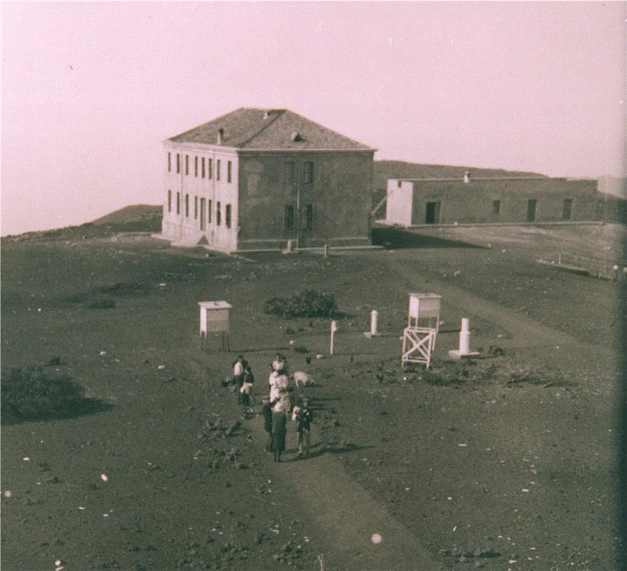
Figure 6. The Izaña observatory around 1930.
Around 1958, foreign scientists began to arrive once again to Izaña, on the occasion of a solar eclipse. Several astronomers and astrophysicists used the Observatory to carry out studies on atmosphere transparency and to test the suitability for astronomical observations. In October, 1968, staff of the Meteorological Institute of Mainz University, headed by Dr. Christian Junge, was temporally at the Observatory to test new instruments to detect and measure atmospheric pollution to be used on board the “Meteor”, a German oceanographic and meteorological ship, in its 1969 expedition.
In the summers of 1973 and 1974, a sounding series was carried out at the Observatory to study atmospheric micro-turbulences in view of the great importance that disturbance has to astrophysical observations. Other studies were made on the transport of aerosols in the Ocean and on the chemical components of the atmosphere. Following his 1979 campaign for the observation of halocarbons Dr. R. A. Rasmussen, from the Oregon Graduate Center for Study and Research (USA) wrote in a letter to Dr. Zalote, head of the Observatory that “the data we are obtaining at Izaña are some of the best in the world”.26
Once again German scientists were mainly responsible for the renewed interest on Izaña. From 1981, Drs R. Schmitt and Balchtrusch, commissioned by Deutscher Wetterdierst, carried out studies on the capability of Izaña as a BAPMoN (Background Atmospheric Pollution Monitoring Network) station, representative of the free troposphere in the southern part of the North Hemisphere. In 1984, 75 years after the 1909 agreement, the governments of Germany and Spain signed another one by which the observatory became a station of the WMO BAPMoN programme under joint co-operation. In 1989 BAPMoN and GO3OS (Global Ozone Observing System) merged in the current GAW programme (Global Atmospheric Watch) of which Izaña is one of the principal stations.
During the last years Izaña has increased at a spectacular rate the quantity and quality of atmospheric observations and the observatory is involved in a considerable number of programmes and experiments such as those of NDSC (Network for Detection of Stratospheric Change). In 2004 the Observatory assumed the functions of main centre for the ozone calibration of the European Brewer specto-fotometres network. Izaña has also a bright future in the role of validating and calibrating satellite sensors. Collaboration with the European Space Agency on this subject is currently ongoing.
This is the happy end of a story beginning with the very ancient attraction of Tenerife and its mountains for scientists and the result of some historical events during the first years of 20th century closely related to the initial development of modern meteorology.
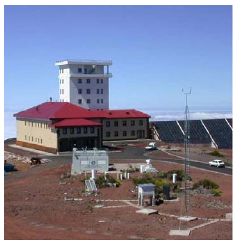 Figure 7. The Izaña observatory today.
Figure 7. The Izaña observatory today.
25 See bibiographical funds of the Instituto Nacional de Meteorología (INM), Madrid. Font was born in Tenerife. He held a relevant position at WMO in Geneva for some years and was the director of the Spanish weather service from 1976 to 1978.
26 Archive of Izaña’s observatory, letter of 28 February 1980
9 Acknowledgements
We wish to thank the director of the Izaña observatory, Dr. Emilio Cuevas, and the former director of the INM, Dr. Mrs Milagros Couchoud, for their support and facilities given for presenting this paper at the ICHM conference in Polling.
10 Main references
Allende Salazar J.M.: La diplomacia española en Marruecos en 1907-1909, published by Ministerio de Asuntos Exteriores (Foreign Ministry), 1990.
Anduaga A., 2000: La Aerología o el estudio de las altas capas de la atmósfera en España en el primer tercio del siglo XX, INM, Madrid
Berthelot S.: Recuerdos y epistolario (memories and correspondence) 1820-1880 translation to Spanish by I.E.C. Ed., La Laguna, 1980.
Buch L. von,1823: Remarques sur le climat des iles Canaries in Annales Chim. et Phys., Vol.22 p. 281-304
Commision Internationale pour l’Aerostation Scientifique: Procés-Verbaux des Séances et Mémories, 1906, 1909 and 1912, several eds.
Dember, H.; Buchheim, W. & Uibe, M., 1919: (in Spanish) Trabajos efectuados en las Islas de Tenerife durante los años 1914 a 1917, Madrid.
De Ory, F., 1998: Ciencia y Diplomacia Hispano-alemana en Canarias (1907 – 1916). Edirca (eds.), 239 pp
Friedman, R.M.: Appropriating the Weather. Cornell University Press
Fritsch, K. Von, 1866: Meteorologisch und klimatographische Beitrage zur Kenntnis del Kanarische Inseln, Petermanns Geogr. Mitt.
Galbis, J., 1950: Testamento Laboral del Ingeniero Geógrafo José Galbis Rodriguez (not published, an edition is being prepared by the National Institute of Meteorology in 2005)
Hann, J. Von, 1897: Handbuch der Klimatologie, Bannerman, pp. 60-63
Humboldt A. von, 1805: Voyage aux régions équinoxiales du Nouveau Continent fait en 1799.
Martín Hernández, U., 1988: Tenerife y el expansionamiento ultramarino europeo (1880 – 1919), Cabildo Insular de Tenerife, Tenerife 1988
Palomares M., 2003: Los Noventa Primeros Años, Ministerio de Medio Ambiente, Madrid, pp. 13-36
Piazzi Smith., 1858: Teneriffe, an astronomic experiment; or, specialities of a residence above the clouds, London.
Torriani, L., 1590: Descripción de las Islas Canarias. Reprinting by Goya eds., Santa Cruz de Tenerife 1978
In journals:
Abercromby, R., 1888: Electrical and meteorological observation on the peak of Teneriffa, Quarterly Journal of the Royal Meteorological Society, Vol. XIV, pp. 101-106.
Biermann, 1887: Beitrage sur Kenntnis der Klimas der Kanarischen Inseln, Meteorologische Zeitschrift
Hann, J. von, 1906: Die Windrichtung auf den Gipfel des Pik von Teneriffa, Meteorologische Zeitschrift
Observatorio Central Meteorológico, 1915 – 1919: Anuario (Yearly report)
